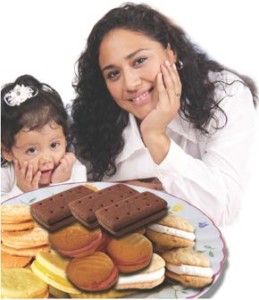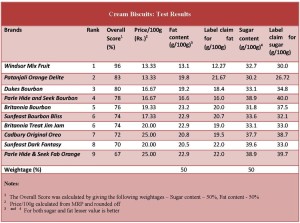Nov.17: COVER STORY
Alarmingly high fat and sugar levels found in Cream Biscuits
Why has FSSAI not set upper limits for these ingredients?
Crunchy, creamy, tasty and tempting. How better to describe cream biscuits? Perhaps, you should add one more adjective – unhealthy. Our tests of 10 popular brands of cream biscuits revealed that most brands had unacceptably high levels of fat and sugar. Cream biscuits give instant energy and appeal to all age groups. However, they are high in calories and low in nutrition.
FSSAI inaction?
Agreed, cream biscuits come in the category of HFSS (High Fat, Sugar and Salt) foods. But how unhealthy the brands available in the market were, was a revelation. Packaged food is the reality of the day. But so are lifestyle disorders like obesity, diabetes and heart ailments caused by excessive consumption of fat and sugar. The Food Safety and Standards Authority of India (FSSAI) is well aware of this reality. Cream biscuits are not a new entrant in the market. Why, then, has FSSAI not set mandatory upper limits for these ingredients in cream biscuits? As of now, there are neither FSSAI nor Bureau of Indian Standards (BIS) standards for fat and sugar in cream biscuits.
Key findings
We tested samples of 10 brands of cream biscuits that were filled and/or coated. Filled biscuits are generally sandwiched with a filling of cream, jam or chocolate. Coated biscuits are covered with chocolate or caramel.
Fat content: According to the National Institute of Nutrition (NIN), ICMR, the recommended desirable visible fat intake per day is 20g for both men and women. In six of the 10 brands, fat content was above 20g/100g. Britannia Bourbon had the highest fat content (23.2g/100g) while Windsor Mix Fruit had the lowest (13.1g/100g). This means that a 100g packet of Britannia Bourbon contains more fat than you should consume in a whole day! (See table for details)
Sugar content: The recommended daily allowance (RDA) for sugar as per the latest norms of World Health Organization (WHO) is 25g (6 teaspoons). All the 10 brands of biscuits contained more than 25g/100g of sugar. Sunfeast Dark Fantasy had the highest sugar content (39.6g/100g) while Patanjali Orange Delite (30.2g/100g) had the lowest. This means that a 100g packet of Sunfeast Dark Fantasy contains much more than your RDA for sugar!
Why biscuits are unhealthy: The basic ingredients of biscuits are wheat flour (usually refined flour or maida), hydrogenated fat, sugar and baking powder. Eating refined wheat flour is not recommended because it is almost devoid of nutrients and fibre. Consumption of hydrogenated fat is known to increase the risk of heart disease and diabetes. The high sugar content gives a sudden spike of energy but constitutes empty calories.
UK norms: UK’s Food Standard Agency (FSA) recommends that fat content of more than 17.5g/100g and sugar content of more than 22.5g/100g be labelled or colour coded as ‘high’. Going by these guidelines, except two products (Windsor Mix Fruit and Parle Hide & Seek Bourbon) all brands fall in the category of ‘high’ fat content. And, all the 10 biscuit brands fall in the ‘high’ sugar category.
Inaccurate label claims: Proper nutritional labelling is vital as consumers need information in order to choose healthy food. The actual fat content was significantly higher than the label claim in three brands. Similarly, in three of the brands, the actual sugar content was significantly higher than the label claim.
Price: High price does not ensure quality. The two least expensive biscuit brands fared the best in our rating based on health parameters.
Best Buy: Our Best Buy is decided on the basis of Overall Score and Price. Topping the chart was Windsor Mix Fruit.
Manufacturers’ response: None of the manufacturers answered our primary question – why do most cream biscuits brands have unacceptably high levels of fat and sugar? They maintained that they had complied with the provision of nutritional information as per labelling requirements. However, there was significant variation in many brands between tested values and label claims.
Urgent action needed
- CERC has appealed to FSSAI to formulate mandatory standards (fix upper limits) for fat and sugar in cream biscuits.
- Labels of biscuit packets should indicate clearly whether the product is high in fat, salt and sugar content as the case may be. UK has a system of colour coding on food packets to indicate this. Why can’t India follow such global best practices?
- Manufacturers should ensure that the values of fat and sugar content mentioned on labels are accurate.
- Manufacturers should make conscious efforts to lower fat and sugar content in cream biscuits and also try to improve their nutritive value in terms of fibre content, vitamins and minerals.
Grahak Sathi’s conclusion: Cream biscuits are high in calories, not a good source of fibre and not a healthy snack replacement. So, should they be avoided altogether? Nutritionists feel that the answer to this question lies in what they replace. If biscuits replace fruits, vegetables and nuts, it is bad. But, if they replace snacks that are more unhealthy (like chaklis and chivdas) they are a better alternative. Also, when you are travelling, they are a safe and hygienic option. So, eat biscuits in moderation and select healthier variants.
Â
Â






